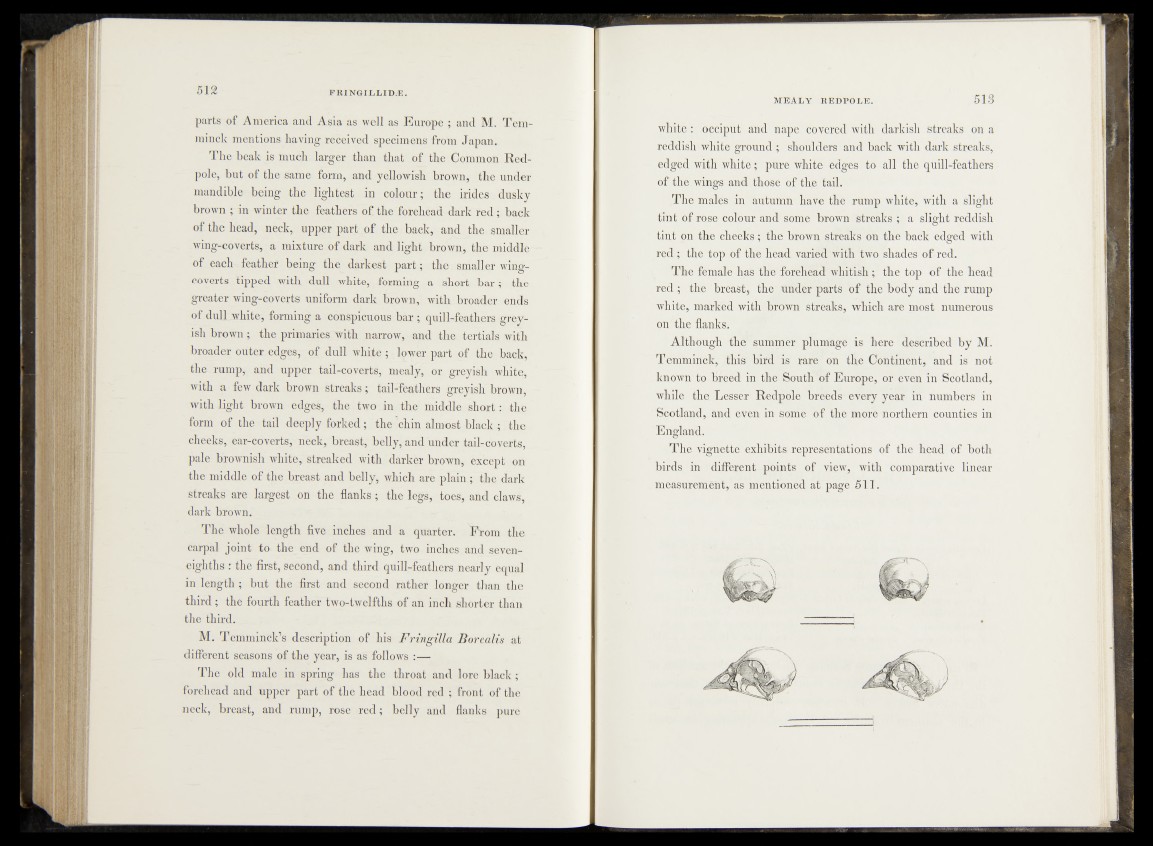
parts of America and Asia as well as Europe ; and M. Tem-
minck mentions having received specimens from Japan.
The beak is much larger than that of the Common Red-
pole, but of the same form, and yellowish brown, the under
mandible being the lightest in colour; the irides dusky
brown ; in winter the feathers of the forehead dark red ; back
of the head, neck, upper part of the back, and the smaller
wing-coverts, a mixture of dark and light brown, the middle
of each feather being the darkest p a rt; the smaller wing-
coverts tipped with dull white, forming a short b a r; the
greater wing-coverts uniform dark brown, with broader ends
of dull white, forming a conspicuous bar ; quill-feathers greyish
brown; the primaries with narrow, and the tertials with
broader outer edges, of dull white ; lower part of the back,
the rump, and upper tail-coverts, mealy, or greyish white,
with a few dark brown streaks; tail-feathers greyish brown,
with light brown edges, the two in the middle short: the
form of the tail deeply forked; the 'chin almost black ; the
cheeks, ear-coverts, neck, breast, belly, and under tail-coverts,
pale brownish white, streaked with darker brown, except on
the middle of the breast and belly, which are plain; the dark
streaks are largest on the flanks; the legs, toes, and claws,
dark brown.
The whole length five inches and a quarter. From the
carpal joint to the end of the wing, two inches and seven-
eighths : the first, second, and third quill-feathers nearly equal
in length ; but the first and second rather longer than the
third; the fourth feather two-twelfths of an inch shorter than
the third.
M. Temminck’s description of his Fringilla Borealis at
different seasons of the year, is as follows :—
The old male in spring has the throat and lore black;
forehead and upper part of the head blood red ; front of the
neck, breast, and rump, rose re d ; belly and flanks pure
MEALY REDPOLE. 513
white : occiput and nape covered with darkish streaks on a
reddish white ground ; shoulders and back with dark streaks,
edged with white; pure white edges to all the quill-feathers
of the wings and those of the tail.
The males in autumn have the rump white, with a slight
tint of rose colour and some brown streaks ; a slight reddish
tint on the cheeks; the brown streaks on the back edged with
red ; the top of the head varied with two shades of red.
The female has the forehead whitish; the top of the head
red ; the breast, the under parts of the body and the rump
white, marked with brown streaks, which are most numerous
on the flanks.
Although the summer plumage is here described by M.
Temminck, this bird is rare on the Continent, and is not
known to breed in the South of Europe, or even in Scotland,
while the Lesser Redpole breeds every year in numbers in
Scotland, and even in some of the more northern counties in
England.
The vignette exhibits representations of the head of both
birds in different points of view, with comparative linear
measurement, as mentioned at page 511.